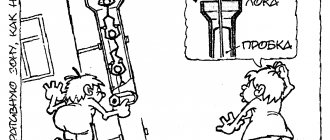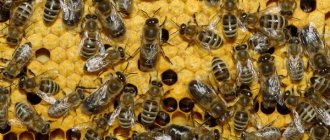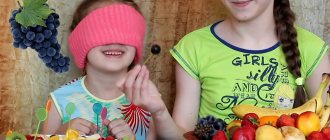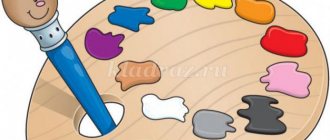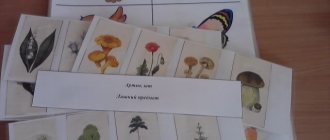Goals and objectives of the additional education program “Gramoteyka”
So, extracurricular activities to prepare children for school are usually held in the preparatory group, but it’s not a sin to start earlier. Lessons, if you can call them that, are taught once or twice a week. Attending the circle is voluntary, at the request of the parents. At the discretion of the kindergarten, these can be free or paid classes.
If the additional education program developed by the kindergarten provides for a literacy club in the senior and preparatory groups, then classes are provided once a week after naps.
Why is a literacy club needed in kindergarten?
To prepare kids for writing, you need to start introducing them to sounds before they start writing letters. If children do not distinguish sounds, cannot distinguish them, or pronounce them correctly, then in 1st grade they will have great difficulties with writing. The technology of teaching in additional education clubs involves teaching children to hear, distinguish, differentiate, and correctly pronounce the sounds of their native speech.
The goal, in short, is to prepare preschoolers for literacy.
Tasks in detail - training, development, educational:
- Acquaintance with letters, basic linguistic concepts (word, sound, letter);
- Do a simple sound-letter analysis of words;
- Compose sentences and words according to a given model;
- Develop broad phonemic awareness and hearing;
- Make simple graphic notes of words and sentences;
- Develop communication skills, vocabulary, correct speech and respect for the native word;
- Prepare your hand for writing.
Work plan for the ABVGDeyka circle in the preparatory (speech therapy) group
Explanatory note.
The work of the ABVGDeyka circle is aimed at introducing preschoolers to literacy, the formation of phonemic hearing, the development of the grammatical structure of speech, and the introduction of sound-letter analysis of words. The curriculum for providing additional educational services is based on manuals for speech development and literacy:
- T.B. Filicheva, G.V. Chirkina “Preparation for school of children with general speech underdevelopment in a special kindergarten: second year of study (preparatory group).” - M.: Publishing House “Alfa”, 1993.
- V.V. Konovalenko “Correctional work of a teacher in a preparatory speech therapy group in the classroom and in the everyday life and activities of children.” - M.: GNOMiD Publishing House, 2008.
- N.V. Nishchev “Notes of subgroup speech therapy classes.” - SPb.: CHILDREN'S PRESS, 2007.
The “ABVGDeyka” circle is study and play. The game form of work is very effective, since it is in the game that the creative abilities of the individual develop. To this end, all direct educational activities include all kinds of speech development games, entertaining exercises, phonetic, lexical, grammatical, graphic (work in notebooks) and even outdoor games.
Direct educational activities to solve the problems of additional education for children “ABVGDeyka” are carried out in the afternoon, 1 time per week, 4 times per month.
The duration of direct educational activities for the implementation of additional education for children is 30 minutes in accordance with SanPiN 2.4.1.2660-10.
The group consists of 18 children.
The form of service provision is group.
Goal: formation of all aspects of speech, preparing children to master literacy, teaching reading skills.
Tasks:
- develop coherent speech in gaming activities;
— maintain children’s interest in the personalities and activities of their peers, promote their dialogical communication in joint games and activities;
- maintain children’s interest in storytelling on their own initiative or at the suggestion of an adult;
- learn to convey verbally the content of a fairy tale, an impression from personal experience in the form of a short essay, story, argument, description;
- develop graphic skills.
Expected result: by the end of the year, students will know:
- all sounds and letters of the Russian alphabet;
- correct position of the notebook when writing;
- be able to isolate the first and last sound in a word;
- correctly name soft and hard sounds outside words;
- divide words into syllables, highlight the stressed syllable;
- write (print) letters of different sizes (large and small);
- make sentences with given words;
- compose a story based on the picture, using the teacher’s sample or his questions;
- correctly pronounce speech sounds, pronounce words clearly and clearly;
- use generalizing words in speech;
- hold the pen correctly;
- navigate on a sheet of paper;
- paint over the drawn object without protruding beyond the outline;
- finish drawing the started figures;
- hatch the drawn object with straight and oblique lines.
| date | GCD | Program tasks | Material | Literature |
| SEPTEMBER | ||||
| 21.09 | "Let's help Petrushka" | Activate, clarify, consolidate vocabulary on the topic “Parts of the body.” Teach children to make sentences based on object pictures. Use words that name an object in speech. Develop children's attention, coherent speech, and thinking. Cultivate a caring attitude towards your body. | Object pictures (parts of the human body and objects), Parsley - picture, notebooks, game “Body Parts”. | Gomzyak O.S., p. 38 |
| 28.09 | “Beauty Autumn” (KVN) | To consolidate and use the ideas about autumn accumulated by children. Continue to teach children to identify the initial vowel sound in a word and the final consonant. Strengthen children's vocabulary: grumpy, string, drizzling, hibernation. Develop dialogical and coherent speech, memory, attention, logical thinking, observation. Foster a love of nature, collectivism, and respect for teammates. | Emblems: mountain ash, autumn leaves; circles (green and red); picture – Pinocchio, forest, bread, migratory and wintering birds; game "Migration of Birds". | Tsukanova S.P., p. 27 |
| OCTOBER | ||||
| 05.10 | “Nature in autumn” (trees, shrubs) | Clarify and expand children's understanding of the diversity of trees and shrubs. To consolidate knowledge about trees and their parts (roots, trunk, crown, branches, leaves). Give an idea of the fruits and seeds of trees, shrubs, and methods of seed dispersal. To consolidate knowledge about the vowel sounds –a, -u; letters -A, -U. Learn to determine the place of sounds in words. Learn to write descriptive stories. Develop children's visual perception and memory, speech, and hand motor skills. Foster respect for nature and love. | Diagram-description of trees, subject pictures (spruce, birch, oak, lilac, acacia); colored pencils, notebooks. | Gomzyak O.S., p.5 Tsukanova S.P., p. 37 Nishcheva N.V., P. 8 |
| 12.10 | “Old Borovichok visiting the children” | Activate children's vocabulary on the topic “Mushrooms”. Continue teaching children to form nouns with diminutive suffixes. Learn to determine by ear the place of the sounds -O, -I in words. Develop coherent speech, the ability to compose stories based on a plan diagram. Develop control over your own speech. | Toy – Mushroom; pictures of mushrooms; notebooks, colored pencils; plan diagram for describing mushrooms. | Gomzyak O.S., p. 11, Tsukanova S.P., p. 39 |
| 19.10 | “We’ll go berry picking” | Continue teaching children to write descriptive stories based on the diagram. Systematize children's knowledge about collecting forest and garden berries. To consolidate children's knowledge of the letters –Y, -E; sound -s. Develop coherent speech, attention, thinking, hand motor skills. Foster a caring attitude towards nature. | Pictures (garden and forest berries); diagram of the description of the berries; ball; notebooks, pens. | Tsukanova S.P., p. 48 |
| 26.10 | “We’ll go to the garden and collect the harvest” | Activate vocabulary on the topic “Vegetables”. Expand the dictionary of features. Continue to teach how to write descriptive stories about vegetables using diagrammatic maps. To consolidate knowledge about the growth of vegetables, their meaning and benefits. Develop the ability to read syllables. Develop the ability to work according to verbal instructions. Foster a desire to express your thoughts and answer questions. | Envelope with a letter; parcel with dummies of vegetables; vegetable description diagram | Nishcheva N.V., p. 23 |
| NOVEMBER | ||||
| 2.11 | “The dog and the cat were making compote” | Teach children to compose stories based on a series of plot pictures with the addition of subsequent events. Teach children to divide words into syllables and highlight stressed syllables. Develop imagination, thinking, speech, attention. Replenish and activate children's vocabulary on the topic “Fruits”. Develop fine motor skills (application), coherent speech, logical thinking, and attention of children. Foster independence and activity in educational activities. | Fruit replicas; tree layouts; glue, brushes, oilcloth; blank "Casserole". | Nishcheva N.V., p. 36 |
| 9.11 | “Vegetables and fruits are delicious products” | Teach children to write comparison stories using reference diagrams. Strengthen the ability to perform actions according to a given algorithm. Reinforce the concepts of “consonant”, “voiced”, “soft”. Develop children's coherent speech through the ability to write descriptive stories. Cultivate an interest in learning new things. | D/i “Wonderful bag”; reference diagrams for composing stories; notebooks, colored pencils. | Smirnova L.N., p.10 |
| 16.11 | "Clothing store" | Form generalizing concepts: “clothes”, “hats”, “shoes”. Clarify the vocabulary on this topic, expand and activate it. Develop the ability to coordinate words in a sentence. Learn to form and use the plural of nouns in speech. Develop attention, memory, imagination, logical thinking, hand motor skills. To generate interest in developing poetic exercises. | Pictures (clothes, hats, shoes); ball; notebooks, pens; d/i “Let’s dress the doll.” | Gomzyak O.S., p. 14, Nishcheva N.V., p. 125 |
| 23.11 | “Let’s help Grandma Fedora” | Strengthen the ability to classify dishes according to method of use: kitchen, dining, tea. Activate generalizing concepts in speech: “dishes”, “tea”, “dining room”, “kitchen”. Strengthen the ability to reason and explain. Differentiation of sounds -н, -н. Continue to teach children to find the place of sound in a word. Learn to determine by ear the number of syllables in words. Develop attention, memory, thinking, speech of children. Foster a sense of responsiveness and mutual assistance. | Doll; box with ribbon; book by K. Chukovsky “Fedorino’s grief”; pictures (tools, shoes, dishes). | Martsinkevich G.F., p. 26 Konovalenko V.V., p. 40 |
| 30.11 | "Travel with Kolobok" | To form the need to correctly use nouns with diminutive suffixes in speech. Continue teaching children to write descriptive stories about food according to the teacher’s plan. Strengthen the ability to find a given sound in a word (letter -P), determine its place, hardness and softness. Develop thinking, continue to teach children to solve riddles. Develop fine motor skills, the ability to use high-quality adjectives in speech, and the ability to compose sentences according to a diagram. Cultivate responsiveness. | Toy – Kolobok; pictures of food; sentence diagrams; leaves with riddles; notebooks, pencils. | Anisimova T.B., Plotnikova T.V., p. 158 |
| DECEMBER | ||||
| 7.12 | “Winter-winter has come to visit us” | Continue to teach children to compose a story based on the picture, using previously acquired knowledge and ideas. Learn to find objects in the environment whose names contain the sound -t, -t, determine the place of this sound in a word, its softness or hardness. Cultivate a sense of beauty. | Painting “Winter fun”; diagram for composing a story; notebooks. | Nishcheva N.V., p.11 |
| 14.12 | “Dad, mom, I am a happy family” | Continue to teach children to identify the first sound in words and compare it with the letter (K, k). Activate children's vocabulary by deepening knowledge about their family. Reinforce the image of the letter -K, teach how to highlight it. Teach children to compose a collective story based on the painting “Family.” Improve dialogic and monologue speech. Cultivate a caring attitude towards your family members. | Subject picture “Family”, group photo album “Family”; family coats of arms. | Gomzyak O.S., p. 22 |
| 21.12 | “Let’s help Baba Capa return the furniture” | Learn to form adjectives from nouns. Learn to use prepositions correctly in a sentence. Expand and activate children's vocabulary on the topic “Furniture”. To develop the ability to find objects in an environment with sound -S. Continue teaching children to divide words into syllables and highlight stressed syllables. Formation of the ability to graphically “write” sentences in notebooks. Strengthen the ability to compose a descriptive story - a riddle about pieces of furniture according to plan. Develop the ability to listen to a teacher, comrade, and follow instructions. | Picture – Grandma Capa; counting sticks; cards with furniture items; ball; descriptive story outline. | Gomzyak O.S., p. 18 |
| 28.12 | “What is New Year?” | Introduce the history of the holiday. Continue to teach children to form adjectives and coordinate them with nouns; change the endings of nouns when coordinating them with numerals (three icicles, five balls, etc.). Learn to come up with words with the letters –X, -K. Consolidate knowledge about winter, clarify the signs of winter. Develop memory, attention, thinking, speech of children. Cultivate interest in Russian traditions. | Picture and graphic plan; d/i “Words on the palm”; pictures on the theme “New Year”; | Martsinkevich G.F., p. 63, 96 Konovalenko V.V., p. 34 |
| JANUARY | ||||
| 11.01 | "How do birds live in winter?" | Reinforce the general concept: wintering birds. Learn to recognize and color familiar birds (tit, pigeon). Learn to read three letter words. Practice forming relative adjectives. Practice the ability to divide words into syllables. Fix the image of the letter –Z. Develop coherent speech, hand motor skills, thinking, memory, attention of children. Develop the ability to interact with each other, love for birds. | Pictures “Wintering birds”, d/i “Make a new word”, feeder, d/i “Put emphasis”. | Konovalenko V.V., p. 42 |
| 18.01 | "Poultry yard" | Continue to teach children to recognize words and differentiate sounds – s – z. Consolidate knowledge of the outlines of the letters –Z, -S. Continue to practice the ability to form the plural of nouns. Strengthen your knowledge on the topic “Birds”. Foster a love of nature and a caring attitude towards birds. | Subject pictures “Poultry” | Martsinkevich G.F., p. 57, 65 |
| 25.01 | "Pets are man's friends" | Strengthen the skills of distinguishing and clearly pronunciating the sounds –P, -Пь; -B, -B. Continue to learn how to write a story based on your observations. Develop phonemic awareness; develop skills in analysis and synthesis of syllables; develop memory and thinking. Cultivate a love for pets and a desire to care for them. | Pictures “Pets”, ball, notebooks, colored pencils. | Kuznetsova E.V., Tikhonova I.A., p. 4 |
| FEBRUARY | ||||
| 01.02 | "Wild Animals and Their Young" | Continue teaching children to write a descriptive story using a given outline. Practice selecting adjectives for nouns. Develop the ability to identify missing letters in a word, compose sentences from these words according to a certain pattern, coherent speech, and attention. Cultivate an interest in the natural world around us and a caring attitude towards animals. | D/i “Animals and their young”, crossword puzzle, diagram, notebooks, pens. | Konovalenko V.V., 44, 86 |
| 08.02 | "The Jungle Book" | Differentiate the sounds K–G. To consolidate and expand children's knowledge about animals of hot countries. Develop visual attention, the ability to recognize objects by dotted patterns and independently complete such a pattern. Improve your spelling and reading skills. Foster a caring attitude towards nature. | Poster with animals from hot countries, cards with mixed up letters; notebooks. | Nishcheva N.V., p. 17 |
| 15.02 | “All professions are important, all professions are needed...” | Expand ideas about the work of adults, its necessity and social significance. Teach to distinguish and name professions by tools. Strengthen the ability to form words in the genitive case, singular; the ability to form sentences with a given word. Differentiation of sounds – S-SH. Continue to teach children to find and highlight the letters -I, -A in given words, determine their place in the word. Teach children to talk about what people in these professions do. Foster respect for the work of adults; | D\i "Professions"; notebooks, pens, colored pencils. | Konovalenko V.V., p. 56 – 58 |
| 22.02 | "Defender of the Fatherland Day" | Strengthen the skill of pronouncing the sound z in syllables, words, phrases. Teach the formation of singular and plural forms of nouns, selection of related words; introduce words denoting objects, actions, signs; learn to select words for diagrams, compose a story based on a series of pictures. Develop phonemic hearing, attention, memory, thinking. To foster pride in one’s Fatherland and respect for defenders. | Pictures (military professions); game “What's extra?”, picture – Pinocchio; notebooks, colored pencils. | Kuznetsova E.V., Tikhonova I.A., p. 36 |
| MARCH | ||||
| 01.03 | “Spring is coming, make way for spring” | Continue teaching children to compose a story based on the picture. To consolidate children's knowledge about the signs of spring and the spring months. Learn to write (copy) their names. Train the ability to solve various types of puzzles. Differentiation of sounds – Zh-Z. Develop the ability to compose words from the given syllables. To instill in children an interest in the changes taking place in nature. | Painting "Spring"; illustrations with signs of spring; bell; notebooks; illustration "Birds". | Gomzyak O.S., p. 32 |
| 08.03 | "Mother's Day - Women's Day" | Systematize and summarize children's knowledge about the spring holiday - March 8. Learn to make sentences with given words. Fix the image of the letters –L, -E. To develop in children the ability to compose stories in accordance with the drawn up plan. Develop children’s ability to select attributes to a noun through D/I “My mother is the most…”; creative imagination, thinking through the game situation “Surprise in the box”. Develop gross and fine motor skills through finger exercises and physical exercises. Cultivate respect and love for the closest and dearest person - mother. | Box, photographs of mothers; toy - heart; notebooks; colour pencils; postcard – Happy March 8th! | Gomzyak O.S., p. 29, Nishcheva N.V., p. 60 |
| 15.03 | "Happy Journey" (transport) | To consolidate knowledge on the topic “Transport”, the ability to distinguish between types of transport (water, land, air). Continue to learn how to write descriptive stories using a diagram. Train the ability to copy (type) words from the board. Develop the ability to come up with words with the letters -E, -O. Develop the skill of dividing words into syllables. Foster independence and interest. | Scheme for composing a story, subject pictures; notebooks. | Konovalenko V.V., p. 94 |
| 22.03 | "City Trip" | Clarify children’s ideas about their hometown, introduce them to some of its attractions. To evoke in children a feeling of admiration for the beauty of their hometown. Continue to teach children to find the place of sound in a word. Develop the ability to break words into syllables and highlight stressed syllables. Learn to write the name of your city correctly. Develop children's thinking and speech. Foster love for your city. | Illustrations of city sights, notebooks, pencils, ball. | Kuritsyna E.M., p. 128 |
| 29.03 | "Enchanted Flowerbed" | To consolidate children's knowledge about flowers (garden, field, indoor). Differentiation of sounds – R-L. Fix the image of the letters –P, -L, -F. Train the ability to fill in missing letters in words, develop the skill of sound-letter analysis of words. Consolidate knowledge on the topic “Flowers. Strengthen the ability to compose and come up with a story on a given topic. Develop the ability to select as many features as possible for an object. Develop attention, speech, and the ability to clearly and loudly answer the question posed; love and care for flowers. | Pictures of flowers: garden, field, indoor. Picture “Structure of a flower.” Cut pictures "Flowers". Notebooks, pens, colored pencils. | Nishcheva N.V., p. 40 Konovalenko V.V., p. 63 |
| APRIL | ||||
| 05.04 | “Messengers of Spring” (migratory birds) | Systematization of knowledge about migratory birds, their appearance, and lifestyle. Clarify and activate vocabulary on the topic “Migratory Birds”. Improve your storytelling skills based on a picture; grammatical structure of speech (formation of possessive adjectives). Develop coherent speech, attention, and thinking in children. Foster independence and love for birds. | Pictures of migratory birds, notebooks, pens, colored pencils. Outline for a story. | Bykova I.A., p. 31-35 Nishcheva N.V., p. 63 Skorolupova O.A., p. 47 |
| 12.04 | "Underwater kingdom" (fish) | Expand your understanding of fish, their appearance, lifestyle, habits. Clarify, expand and activate your vocabulary on the topic “Pisces”. Improve the skills of reading and “typing” words with the letters covered. Exercise children to draw conclusions in composing a story - comparisons according to plan. Develop coherent speech, visual perception and attention, coordination of speech with movement. Foster love and respect for nature. | Pictures “Pisces”, colored pencils, notebooks. Cut picture "Fish". | Nishcheva S.P., p. 26, 45. Konovalenko V.V., p. 60 |
| 19.04 | "In the world of insects" | Strengthen the ability to write descriptive stories based on a diagram. Practice retelling texts. Replenish children's vocabulary on the topic “Insects”. Develop the ability to structure your statement logically and consistently. Strengthen the use of possessive adjectives in speech. Fix the image of the letters –S, -C, -Y. To instill in children self-control of speech and respect for insects. | Pictures of insects, mini-museum “Insects”. Text for retelling “Migratory Beetle”. | Gomzyak O.S., p. 9. Nishcheva N.V., p. 51 |
| 26.04 | "Magic Briefcase" (school supplies) | Summarize children's ideas about school and school supplies. Expand, clarify, activate the vocabulary on the topic “School supplies” (school, student, teacher, class, lesson, break, study, knowledge, textbook, notebook, pencil case, folder, diary, etc.). Improve skills in composing and reading words and sentences. Develop the ability to tell stories according to plan. Strengthen the ability to complete words by inserting missing letters into them (-CH, -L, -Y). Form readiness for school. | Pictures of school supplies. Picture – Pinocchio. Notebooks, colored pencils. | Bykova I.A., p. 57 Nishcheva N.V., p. 184 |
| MAY | ||||
| 03.05 | “Spring in the Village” (spring agricultural work) | Expand ideas about the need and importance of adult work. To form ideas about people’s work in the village in the spring. Expand and activate the vocabulary on the topic “Spring agricultural work” (worker, grain grower, vegetable grower, gardener, shepherd, field, garden, vegetable garden, greenhouse, pasture, plowing, sowing, whitewashing, tractor, plow, harrow, shovel, rake, seeds, bucket, brush; spring, black, wet, white; plow, harrow, loosen, dig, whitewash. Sow). Develop skills in forming complex words. To develop practical planting skills. Improve the grammatical structure of speech. Improve the skills of syllabic analysis of words. Automate the pronunciation of the sound [Ш – Ш] in a sentence. Develop mental activity as a result of completing tasks and solving riddles. Learn to form nouns with a diminutive meaning. Foster a positive attitude towards work and interest in agricultural work. | Pictures on the topic “Work in the countryside in spring”, subject pictures with images of tools and tools, d/i “What’s extra?”, counting sticks, boxes of soil, seeds (onion, dill, parsley, cucumber), watering can. | Konovalenko V.V., p. 52 |
| 10.05 | "Victory Day" | Expand children's ideas about the army (soldiers during the Second World War, soldiers fought bravely and defended our country from enemies). Clarify children's knowledge about the holiday - Victory Day. Teach children retelling. Continue to work on the development of coherent speech, improve dialogic and monologue speech, and strengthen the ability to answer questions. Foster a sense of respect for WWII veterans and a desire to care for them. | Album “Photographs of the War Years”, album “Badges”, d/i “What should a warrior-soldier be like?” | Konovalenko V.V., p. 66 |
| 17.05 | “Dunno visiting the children” (repetition) | Clarify the concept of “sound”; consolidate the sound-syllable analysis of words; develop the ability to compose sentences with prepositions, read and type words and sentences; develop thinking and attention. Foster independence. | Picture (Dunno), envelopes with assignments, “magic basket”, notebooks, pens. | Kuznetsova E.V., Tikhonova I.A., p. 23 |
List of used literature.
- I.A. Bykova “Teaching children to read and write in a playful way”: Methodological manual. - SPb.: “CHILDHOOD-PRESS”, 2005.
- S.P. Tsukanova, L.L. Betz “Teaching a child to speak and read.” - M.: Publishing House GNOM and D, 2008.
- N.V. Nishcheva “Notes of subgroup speech therapy classes in the preparatory group of a kindergarten for children with special needs development.” - SPb.: CHILDREN'S PRESS, 2008.
- We speak correctly. Lesson notes on the development of coherent speech in the preparatory school logo group / O.S. Gomzyak. –M.: Publishing house GNOM and D, 2007.
- Kuznetsova E.V., Tikhonova I.A. “Steps to the school. Teaching literacy to children with speech impairments: lesson notes. - M.: TC Sfera, 2001.
- Smirnova L.N. “Speech therapy in kindergarten with children 6 – 7 years old. - M.: Mozaika - Synthesis, 2006.
- Shorygina T.A. “What months of the year?! Journey into the world of nature." - M.: Publishing house GNOM and D, 2001.
- Shorygina T.A. "Trees. What are they like? A book for educators, tutors and parents. - M.: Publishing House GNOM and D, 2001.
- Workbook for the preparatory school speech therapy group of kindergarten / Nishcheva N.V., 2001.
- Pimenova T.I. “I want to pronounce...”: Didactic material. - St. Petersburg: KARO, 2006.
- Entertaining ABC studies: Book. For parents, teachers and dear children / Author-comp. V.V.Volina; Artist L.M.Rudakovskaya. - 2nd ed., revised - M.: Education, 1994.
- Martsinkevich “Teaching literacy to preschool children.” Lesson plans .- Volgograd: Publishing house "Teacher", 2000.
- Kuritsyna E.M., Taraeva L.A. “We are speaking correctly. A big book of classes on speech development." - M.: ROSMEM, 2006.
- Corrective work of a teacher in a preparatory speech therapy group in the classroom and in the everyday life and activities of children / V.V. Konovalenko. – M.: Publishing house GNOM and D, 2008.
- Classes for preschool children on the topic “Spring. Insects. Migratory birds". – M.: “Publishing house Scriptorium 2003”, 2010.
Electronic resources.
- https://ped-kopilka.ru/vospitateljam/zanjatija-s-detmi/podgotovitelnaja-grupa-dou/page-2
- https://vospitatel.com.ua/zaniatia/rech/pomojem-neznaike.html
- https://www.maam.ru/obrazovanie/zanyatiya-po-razvitiyu-rechi
How to organize classes in a circle?
If you decide to organize a circle yourself or you have been burdened with circle work, I advise you to study the following literature:
- “Literacy. Intellectual development of children 5-6 years old" is a collection of tasks and games for a literacy club;
- “Basic educational programs in primary school (projects). Internet installation software: perspective. Promising elementary school. School of Russia” - in order to prepare children for school, it is important for the teacher to know what the school literacy program provides.
The organization of classes in the circle is based on three pillars: entertaining, educational, and effective. We start from this when preparing notes for a class on circle work for children 5-6 years old.
Methods used in circle classes: surprise moments, travel games, conversation, didactic games, riddles, word games.
During classes we use visual aids, toys, subject pictures, videos, etc. We definitely include finger exercises and games! To make the activity exciting for preschoolers, we come up with a fabulous journey, say, to the land of “Write and Read”, where Queen Gramota rules the “Glasiks” and “Consents”. With these heroes you can come up with different adventures to guide the children to complete tasks.
I think I’ll dedicate a separate article to the “Literacy” tasks someday. That's all for now. If you liked the article, click and like it, and if you want to read new materials, subscribe to the news. It's simple.
Sincerely, Tatyana Sukhikh! Till tomorrow!

